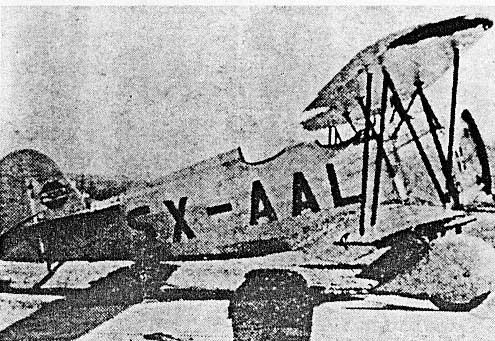.

AEKKEA-RAAB Schwalbe II (temporary registration). The image was kindly provided by Mr. Michalis Pararas.
The history of AEKKEA, an aircraft maker based in Greece, is connected with the fascinating history of a talented German aircraft designer, Antonius Raab (or Antonio Raab, as he was often called after his involvement in Spain). In Germany, Raab was the co-founder of Raab-Katzenstein, an aircraft manufacturing company. A devoted anti-Nazi, Raab was forced out of his homeland, and after attempts to establish his company in Estonia and Latvia, ended up in 1935 in Greece, where he had the support of a high-ranking Latvian Air Force officer. With this support, he and his Greek partners founded a company called AEKKEA (which stood for "Anonymos Etaireia Kataskevis Kai Ekmetallefseos Aeroplanon", or, in French, the "international" language employed in Greece at the time "Societe Anonyme Pour la Fabrication et l'Exploitation des Avions Raab") with headquarters in Piraeus, moving it in 1937 to nearby Phaleron. Construction was undertaken by Pyrkal defence industry until AEKKEA's own factory in Moschato started operation in 1937.
The company employed Greek staff (including management and engineers like Greece's best known aircraft engineer, G. Pangakis), but a number of German technicians had also followed Raab to Greece. Its first reported prototypes were (or were related to) models from Raab’s previous company, including the Pelikan trainer and touring plane, the R-26V trainer and light fighter, the R-27 single-seat fighter, the Schwalbe (I/II) and the Tigerschwalbe IV multi-role military aircraft. The first company "construction" was actually an old Raab-Katzenstein Schwalbe Kl 1c upgraded to Schwalbe II, and at least one complete Schwalbe II was also constructed. Except for the Schwalbe, and, possibly, a Pelikan, no production is verified for any other of the particular types; the company nonetheless possessed the designs and production rights. The first "job" of the new company was an order from Austria for two Schwalbe and two Tigerschwalbe, which were built under licence by Pintsch in Vienna. No further Austrian orders were made, under German pressure. At least one Schwalbe II was active with the Austrian Air Force when that country was annexed by Germany. The Turkish government had also at some point expressed interest in the Schwalbe. AEKKEA also produced dozens of gliders on modified German designs (Gruene Post, Grunau Baby and Zoeglin types, sold and used locally), as well as a large number of spare parts for other aircraft and a variety of specialized equipment for the Greek armed forces, some exports also being made.
In 1936, Raab's design division in the Greek company designed some new types, such as the R-29 and Tigerschwalbe 33 military aircraft, and the R-52 bomber and transport plane. Of those, the first two were to be produced for the Republican forces in the Spanish Civil War, which Raab supported, while the third probably remained a design. Raab had to deal with the complications of supplies to Spain in that period (non-intervention treaty); a commercial office of the Greek company was set up in Paris, while a subsidiary was created in Spain. The main and more complex parts and equipment of the aircraft were built in Athens (parts of the construction were undertaken by Pyrkal, while KEA equipment were also used) and shipped to Spain. Residents of Moschato described seeing truckloads of aircraft parts leaving the factory, obviously heading to ships destined for Spain, while others complained for the continuous noise made during testing of aircraft engines in the factory. Once in Spain, the local subsidiary undertook assembly and completion, in a former textile factory in Sabadell under Raab's supervision (according to some reports, a number of planes were shipped from Greece almost completely finished, the only remaining step being fitting of engines and machine guns). According to Raab, a total of 60 (i.e., 30 of each type) aircraft were almost finished, when they were shipped, along with the construction plans, to the USSR. Raab was arrested as a "German spy", but managed to escape and returned to Greece in 1938.
A proposal to sell aircraft to the Greek Air Force was rejected, as the AEKKEA types were considered "not up to the desired standards". This rejection, however, was probably more connected to politics than technology. Nonetheless, one aircraft (probably a Schwalbe) was being built for a Greek customer when the country was invaded by the Germans and the factory ceased operations, and could be seen, unfinished, in the site of the factory for years after the end of the war. During the German invasion, Raab escaped the country and eventually ended up in India, where he set up a short-lived aircraft factory (it built 2 gliders). In 1949, he returned to Europe, living in Germany and Italy until 1985. AEKKEA was formally dissolved in 1951.
References
* L.S. Skartsis and G.A. Avramidis, "Made in Greece", Typorama, Patras, Greece (2003).
* Jane’s "All the World’s Aircraft" (1936-1937 ed.)
* Antonius Raab, "Raab Fliegt (Erinnerungen eines Flugpioniers)", Reihe Konkret, Hamburg (1984).
* Greek Civil Aviation Authority Archives
| Ancient Greece
Science, Technology , Medicine , Warfare, , Biographies , Life , Cities/Places/Maps , Arts , Literature , Philosophy ,Olympics, Mythology , History , Images Medieval Greece / Byzantine Empire Science, Technology, Arts, , Warfare , Literature, Biographies, Icons, History Modern Greece Cities, Islands, Regions, Fauna/Flora ,Biographies , History , Warfare, Science/Technology, Literature, Music , Arts , Film/Actors , Sport , Fashion --- |
Retrieved from "http://en.wikipedia.org/"
All text is available under the terms of the GNU Free Documentation License

